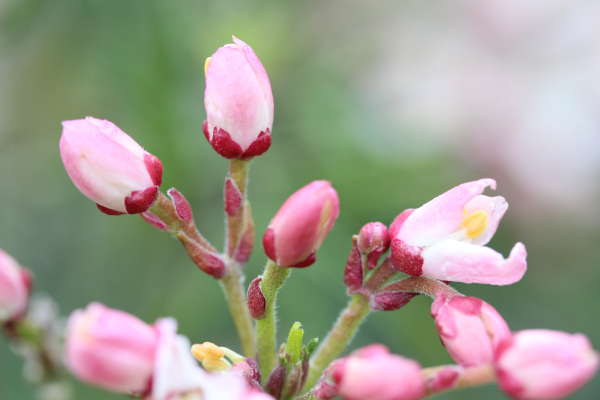How to grow Choisya
Also known as Mexican orange blossom, choisya is a genus of naturally rounded, evergreen shrubs hailing from canyons and rocky slopes in SW USA and Mexico. Despite these hot, dry origins choisya seems to enjoy conditions here in the UK, where it has become a much-used garden favourite – particularly in milder regions. It is grown for its glossy, year-round foliage which can be slender and narrow or chunky and broad, depending on the species/ cultivar. Its white, highly fragrant flowers are another notable feature. Their main moment is spring, though it is not unusual to get a smaller, second flush in autumn as well (particularly if you give it a trim after flowering). As the common name suggests, choisya is in the same plant family as citrus (rutaceae). Although the fragrance of its flowers doesn’t quite match these powerfully perfumed relatives, it is still pleasantly sweet, and it is therefore worth choosing a planting location where this can be appreciated.
Choisya makes a long-lived, easy addition to the garden where, so long as it is not exposed to very harsh winters or strong, cold winds, it will grow without fuss. From compact, container-friendly forms to a range of leaf colours and even bicoloured flowers, there is a choisya to suit most tastes and gardens.
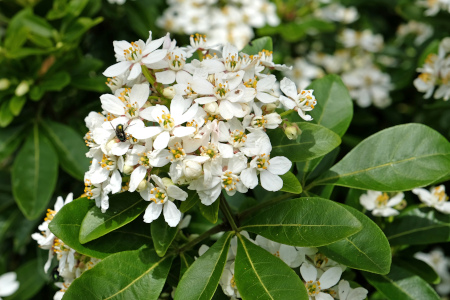
Key Information
Position
Soil Conditions
Hardiness

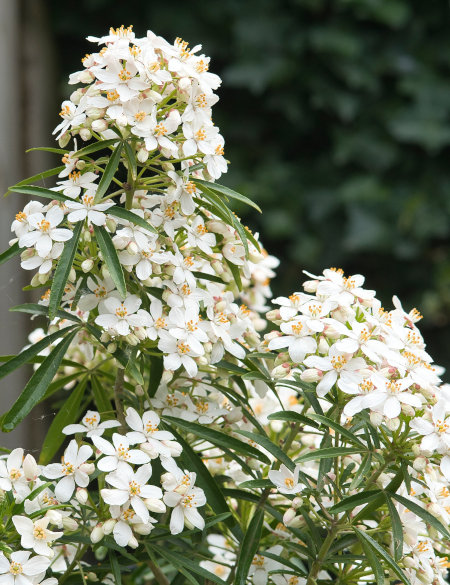
Position - Best flowering occurs in full sun, though light shade is also fine. The latter is in fact preferable for yellow-leaved forms such as ‘Sundance’, which can bleach to almost white in full sun.
Soil - Any fertile, well-draining soil. Avoid the extremes of very wet or dry.
Flowering Period - Spring, and sometimes again in autumn.
Hardiness - Hardy in the average UK winter. Rated H4, meaning able to withstand temperatures dipping to between -5°C and -10°C. Anecdotally, it is said to be okay at -10°C, though defoliated by -15°C.
Though there are 8 species, Choisya ternata is by far the most widely grown and has been used to produce many different cultivated forms – the golden yellow leaved ‘Sundance’ being perhaps the best known. It has also been crossed with C. dumosa to create the C. x dewitteana hybrid, known for its slimmer leaves and abundance of flowers in varying degrees of pink and white. Popular forms of this cross include ‘Apple Blossom’, ‘White Dazzler’, ‘Goldfingers’, and ‘Aztec Pearl’.
Where & when to plant Choisya
Choisya usually comes as a pot grown plant. This means it can be planted at any time of year, though best results are achieved from a spring planting, which gives it time to settle in before being faced with the challenges of a UK winter. Planting can also be carried out in summer, though be prepared to water regularly. Autumn is another option if you live in a milder part of the country (generally the south and coastal areas).
Choisya enjoys a sunny or lightly shaded spot which is sheltered from northerly and easterly winds. Against a protective wall or building is a good idea, as is nestled in a tucked away border, or growing as an informal hedge somewhere out of the wind. Choiysa will also grow happily in a container – go for a smaller variety such as ‘White Dazzler’.
Remember also to aim for a planting spot which will allow the scent of the flowers to be enjoyed in spring, such as alongside a much-frequented path or near a doorway.
How to plant Choisya
- For planting into the ground, start by watering the roots well and allowing them to drain before planting.
- Dig the soil area over, removing any large stones and weeds and breaking up any lumps. Mix in a generous amount of organic matter such as manure or garden compost.
- Rake level and firm with your heels. Rake level again.
- Now dig the planting hole, aiming for twice the width of the rootball.
- Place the plant in the hole, ensuring the top of the rootball sits level with the surface of the soil. Too low and the stem can rot, too high and the roots can dry out.
- Backfill with soil and firm in gently with your foot.
- Soak well with water.
- Mulch around the base with well-rotted organic matter such as manure or garden compost.
- For planting in containers (remember, smaller forms are best), first choose an appropriately sized pot. The best practice is to start just a few centimetres larger than the root ball and go up in size gradually every year or so. Always ensure there are plenty of drainage holes in the bottom.
- Again, water the roots thoroughly and allow to drain before potting.
- It can be a good idea to fill and plant your pot in situ to save yourself the trouble of moving it once full.
- Use a good quality potting compost with plenty of horticultural grit mixed in, and, if not already present in the compost (check the description on the bag) some slow-release fertiliser granules.
- Start by partially filling the pot with compost; enough so that when placed on it the top of the roots sit about 3cm lower than the top of the pot.
- Infill all the space surrounding the roots with compost, firming down with your fingers then adding a little more so the plant is held tight.
- Pick up the pot (if you can!) and lightly tap on the potting bench or ground a few times to help further settle the compost around the plant.
- Soak well with water.
- A mulch with horticultural grit will look attractive and help to prevent a ‘cap’ or crust forming on the top of the compost (something container plants can suffer due to the artificial nature of their watering).
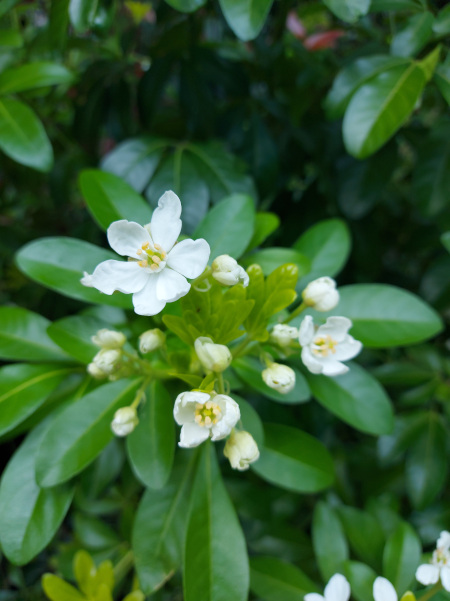
What to plant with Choisya
Choisya is a hugely versatile shrub which suits virtually any style of garden or planting. Other plants which share a love of the same sheltered conditions include ceratostigma, hamamelis, escallonia, coronilla, and leycesteria.
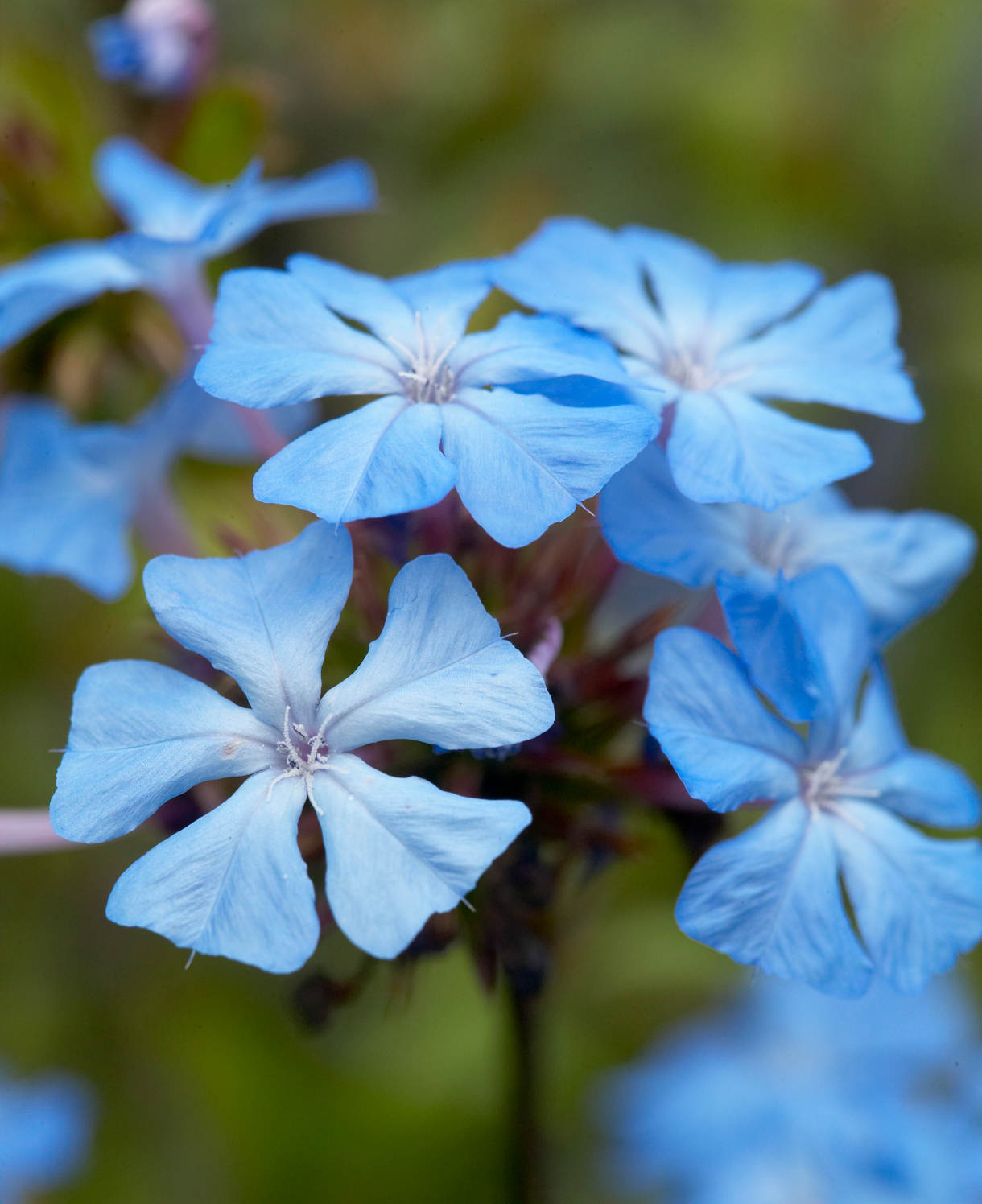
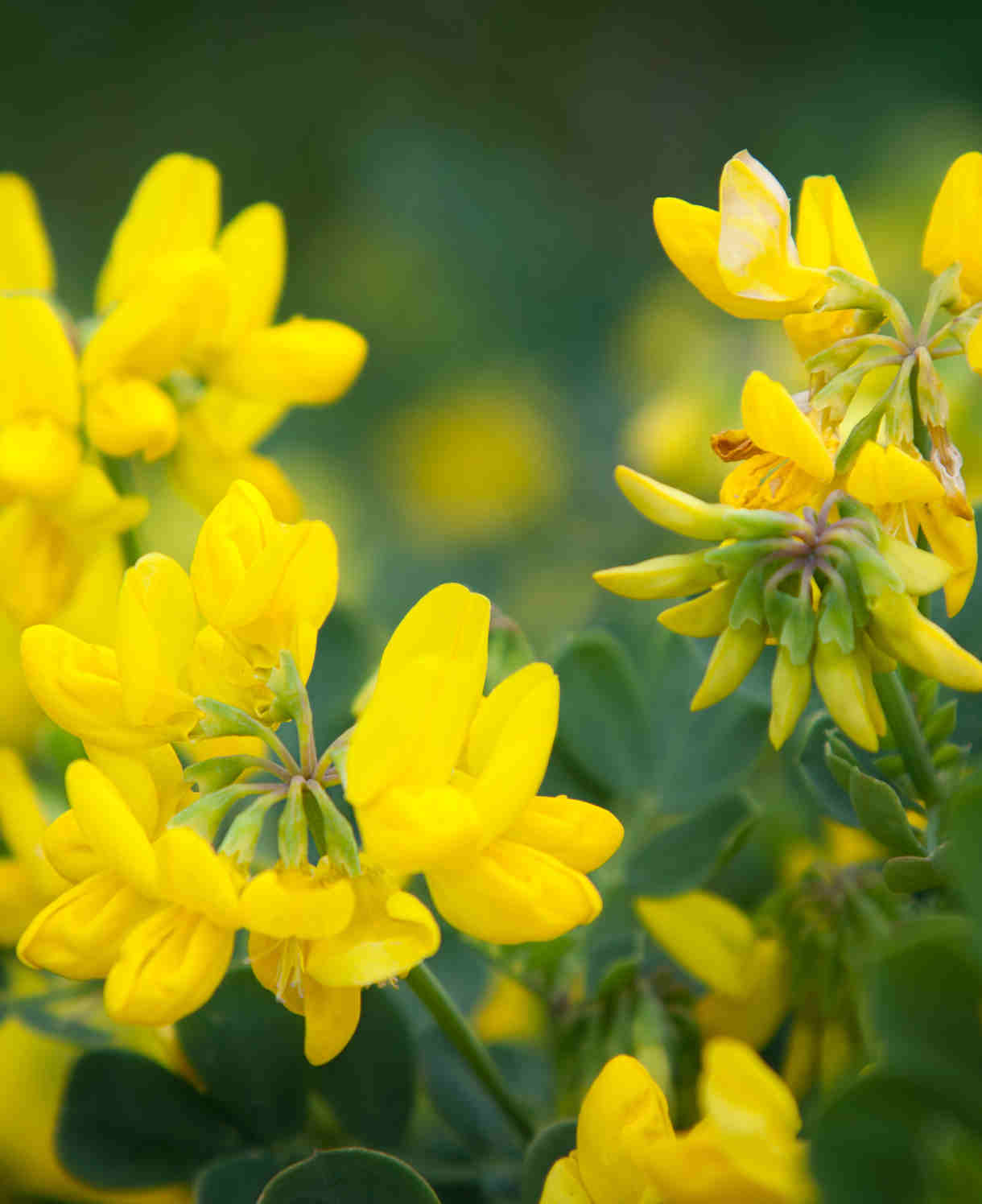

How to care for Choisya
Pruning and Deadheading
Choisya is classed as RHS Pruning Group 8. This means it can be left untouched, apart from occasional removal of dead, diseased, damaged, or badly placed branches – best done immediately after flowering. If you do wish to maintain a certain size and shape (perhaps if growing it as a hedge or in a space slightly too small to allow it to grow freely), trim back to the desired dimensions immediately after flowering. If it becomes too large, you can cut it back hard with no ill effects. Just make sure you water it afterwards to encourage quick recovery, particularly if the weather is dry.
Watering
Like all woody plants, choisya should be regularly watered during its first couple of growing seasons in the ground while its roots become established. After this it is more drought tolerant than most shrubs and should be largely self-sufficient, though it still pays to water in prolonged periods of hot, dry weather. An annual mulch is also useful for locking in moisture – more on this in our ‘Feeding’ section below.
Container-grown choisya has less access to moisture so will need to be regularly watered throughout every growing season. Allowing the top couple of centimetres of compost to dry out between watering is a useful rule of thumb to help avoid overwatering (choisya hates to sit in soggy compost), though be aware that during the height of summer this can happen in as little as 24 hours. Wiggle your finger into the compost to check. From mid-autumn, the British climate tends to take over watering needs, though do remember to step in in the event of an unseasonably dry spell.
Feeding
To give it the best possible start, feed choisya for its first couple of years in the ground with a general-purpose granular feed applied to the surface of the soil and lightly worked in (known as a ‘top dress’). This is best done in late winter, along with a mulch of well-rotted organic matter (i.e., a layer of manure or garden compost applied to the soil around the plant), which has the added benefit of suppressing weeds and locking in moisture.
Once your choisya is well established an annual mulch should provide sufficient nutrients, however, apply a top dress as above if ever you feel an extra boost is needed.
Container-grown plants rely more on the gardener for nutrition. Get off to a flying start by making sure you use a good quality compost with slow-release granules mixed in, then throughout the growing season (March to September) apply a monthly liquid feed. An annual top dress is also advisable: each spring, scrape off the top 5cm of compost and replace with fresh.
Cold Protection
When grown in the right spot (shelter from cold winds, good drainage), choisya should be hardy enough to withstand winter throughout most of the UK without the need for additional protection. Where winters are particularly harsh (more northerly or exposed gardens), it can be worth protecting young shrubs with a fleece jacket or similar whenever a cold spell is forecast.
Like all plants, those grown in containers can be more vulnerable to the cold. Wrapping pots with hessian or fleece is a useful winter habit to establish. As well as insulating roots, this protects the pot from cracking.
Pests and Diseases
Choisya tends to be largely problem free (the aromatic oils in its leaves deter most pests), though can be prone to damage from snails – particularly when the growth is young and tender in spring.
Encouraging natural predators such as birds, frogs, toads, and hedgehogs, will make a big difference. Torchlight searches after dark (when snails are at their most active) are also effective, allowing you to collect the offending molluscs in a bucket and dispose of as you see fit. Relocating to a nearby woods or bagging up and putting in your freezer before popping them in the bin are said to be the most humane approaches.
How to propagate Choisya
This evergreen shrub is best propagated by semi-ripe cuttings in late summer, using growth that is becoming firm and woody at the base but is still flexible at the tip.
- Snip cuttings off the plant, if possible taking a longer piece than the ideal eventual length of around 10cm (to allow for trimming).
- Put them in a plastic bag straight away to prevent drying out.
- Fill several pots with a well-draining compost mix.
- Trim the end of the cutting to just below a node (point at which leaves grow).
- Remove lowest leaves and soft tip, leaving 2-4 leaves.
- If the remaining leaves are large, cut them in half with a sharp knife (to reduce water lost through transpiration).
- Insert the cuttings into the compost and water lightly. Several cuttings can be put in the same container if there is enough space to do this without them touching.
- Place in a greenhouse or propagating unit if you have one or covered with a plastic bag on a windowsill if not (out of direct sunlight).
- Keep the cuttings misted and occasionally watered until they root. You will know this has happened when roots emerge out of the bottom of the container – expect this to happen the following spring.
- Gently remove rooted cuttings and pot them into individual pots. Grow on in a cool yet frost-free environment such as an unheated conservatory, greenhouse, or cold frame, until they are large enough to be planted out.
* Many plants carry Plant Breeders Rights and cannot be propagated for commercial purposes.
Common Choisya questions
- When should choisya be pruned?
Immediately after the spring flush of flowers. This shrub blooms on growth from the previous year, so pruning it straight after flowering means maximum ‘flower power’ the following year. - Will choisya grow in shade?
Some light shade is fine, though too much will result in weak, straggly growth and fewer flowers. - Does choisya flower twice?
It is not unusual for choisya to bloom again in autumn, particularly if you trim it after the spring flowering period.
